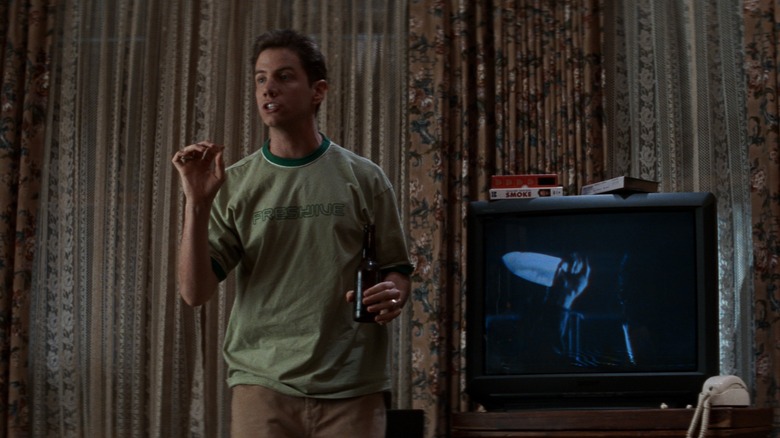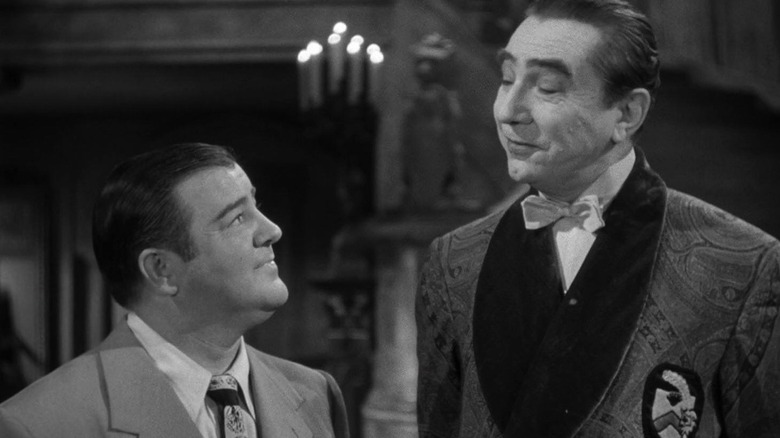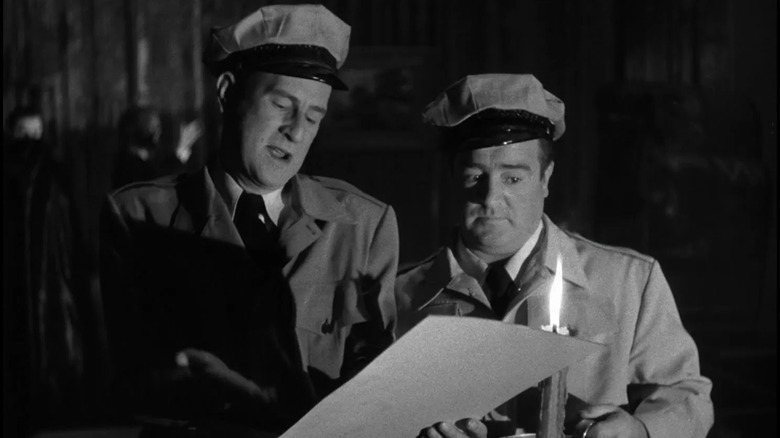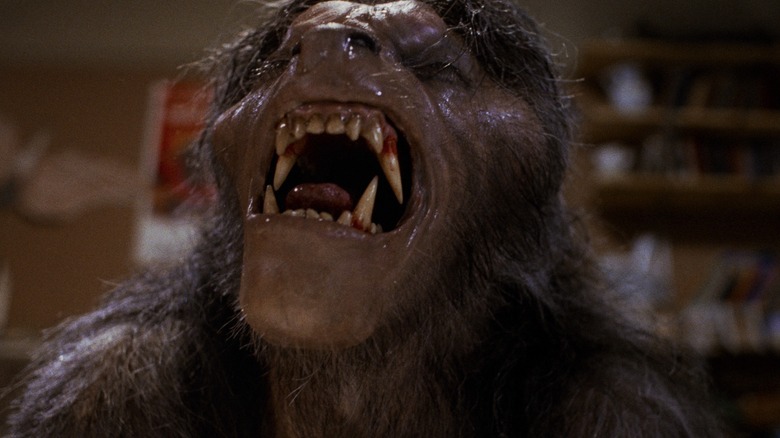What Are The Elements Of A Good Horror Comedy (Beyond Comedy And Horror)?
We recently took a look at the 20 best horror comedies and it got me thinking about the elements that make up the genre and what exactly constitutes a good "horror comedy" beyond the superficial words in that description. Some movies defy classification, but a fan of any genre might soon start to notice certain recurring tropes that could go toward building a base-level definition of it. Randy Meeks, the all-knowing geek played by Jamie Kennedy in "Scream" (1996), might go so far as to label these tropes "the rules" of the genre, though of course, rules were made to be broken.
As I see it, horror comedies are a little different than horror films that are simply broken up with comic relief. They often juggle bigger tonal shifts or foreground the comedy and let the horror function as its own sort of anti-relief. These movies can put a funny, knowledgable spin on well-worn genre ideas, keeping the viewer off-balance with inventive twists. Or they can just let you laugh and make you feel good as you marinate in the familiar trappings of werewolves, zombies, vampires, Frankenstein's monster, and other mix-and-match terrors from the betting-pool whiteboard in "The Cabin in the Woods" (2012).
If a thriller thrusts ordinary people into an extraordinary situation, and horror ups the supernatural and/or gore quotient with that, then a horror comedy might be regarded as a film where the audience enters a funhouse with all their horror literacy, ready to get lost for a while. These are movies made by horror fans, for horror fans. The genre is fluid, and occasionally, you might even encounter a horror comedy with a downbeat ending. More often than not, however, these films are designed as entertaining joyrides.
Horror comedies usually run short
On Valentine's Day 2022, I posted a love letter to Ivan Reitman's "Ghostbusters" (1984) and how it rewrote the rules of genre cinema. According to Box Office Mojo, "Ghostbusters" still ranks as the most successful horror comedy of all time. It's in a league of its own, and for moviegoers of the 1980s, it may have been their starting point for comedy horror, though the genre dates back much further than that.
Films like "Gremlins" (1984), "Fright Night" (1985), "Evil Dead II" (1987), "Tremors" (1990), "Shaun of the Dead" (2003), "Zombieland" (2009), "Krampus" (2015), "One Cut of the Dead" (2017), and "Werewolves Within" (2021) all laugh in the face of fear as their human protagonists face off against supernatural threats. Then, there are movies like "Tucker and Dale vs. Evil" (2010), where it's humans versus humans, or "Young Frankenstein" (1974) and "What We Do in the Shadows" (2014), where the monsters and their creators are the main characters.
The above-mentioned films feature runtimes as short as 84 minutes, with the median range being 97 minutes, and a couple of them topping out at 106 minutes. The one exception to this is "Scream," which clocks in a little longer at 111 minutes, but this opens up the question of whether "Scream" is truly a horror comedy or just a meta slasher film with comic relief. Either way, contrast those runtimes with the recent comedy thriller, "Fresh" (2022), which edged up closer to the standard 2-hour movie mark with a runtime of 114 minutes.
It's an interesting thing to consider: are comedy and horror, by nature, better suited to shorter attention spans? Is it just impossible to sustain the mix of laughter and terror for a full two hours? Could a "horror dramedy," if there is such a thing, possibly bend the informal runtime rule?
In looking back at the genre's earliest roots and how it came to be, one title that is unavoidable is "Abbott and Costello Meet Frankenstein" (1948), which was sort of the "Ghostbusters" of its day, and which, at 82 minutes, still registers as one of the shortest horror comedies you'll ever see.
Abbott and Costello meet comedy horror
When the duo of Abbott and Costello, famous for their "Who's on First" comedy routine, entered "McDougal's House of Horrors" on a dark and stormy night, they led the way for an entire cross-genre strand of films. "Abbott and Costello Meet Frankenstein" was the first hit horror comedy, proving there was an audience for these kinds of movies.
It should really be called "Abbott and Costello Meet the Universal Monsters." The title sells Dracula and the Wolf Man short, and this is more their show, with Bela Lugosi returning to reprise his role as the Count for the first time since the original "Dracula" in 1931. "Look into my eyes," he says, often veiling his face with his cape so that's all you can see of him.
It's still a delight to watch Wilbur (Costello) trade snappy patter with Chick (Abbott). The horror peeks out of a coffin; it's there and Wilbur knows it, but Chick won't listen to him. Chick plays the straight man, grouching his way through the movie and providing a skeptical foil to Wilbur, who gets all the best lines and all the girls, though one of them is bent on transferring his brain to the Frankenstein monster's body.
The film opens with the Wolf Man in London, well ahead of "An American Werewolf in London," and its third act anticipated "Get Out," another film involving brain transplants and one half of a famous comedy duo, Jordan Peele. There are moments, too, where Wilbur sneaks glances at the camera, breaking the fourth wall and giving us glimpses of future meta horror like the aforementioned "Scream."
It's not until the end that Glenn Strange's Frankenstein monster really comes alive, throwing a woman out the window with as much force as Boris Karloff's monster hurled a little girl into a lake. Vincent Price also makes a voice cameo as the Invisible Man. If it ever starts to feel like the current movie landscape is flooded with quippy superhero team-ups, just remember that Universal did it first with their monsters and two vaudeville comedians.
An American Werewolf in London broke the comedy mold
If "Abbott and Costello" helped establish the rules, one particular horror comedy presents a weird little case study in breaking them. Many horror comedies are funnier than they are scary, and when we watch them, we know that everything will be alright in the end. By contrast, "An American Werewolf in London" (1981) wields comedy as a weapon to heighten the mood of horror. The film's intermittently lighthearted tone disarms the viewer so that we, like the main character, David Kessler (David Naughton), don't always know we're in a true horror movie.
The first act of "An American Werewolf in London" almost plays out like folk horror, as David and his backpacking friend, Jack (Griffin Dunne), get off the back of a sheep truck in the English countryside. They wander into a pub with a beheaded wolf on the sign outside and a pentagram on the wall inside. The locals are clearly not accustomed to outsiders and things soon become awkward enough for David and Jack to leave, but not before they're warned to stay off the moors.
Dread permeates these early scenes, and it only gets worse as the movie goes on and the werewolf curse takes effect in a gnarly transformation with Oscar-winning makeup effects by Rick Baker. The beautiful nurse, Alex, who sits down on David's hospital bed and feeds him, then takes him home with her and falls in love with him, reeks of male fantasy. Jenny Agutter makes it work, but writer-director John Landis was coming off "Animal House" and "The Blues Brothers" when he made this film and it would be his last before "Twilight Zone: The Movie." Knowing the deaths that occurred on the set of that film and later Landis family history only leads to more discomfiture when David sits down in a porn theater with the undead spirits of several people who died because of him.
In the end, "An American Werewolf in London" is just one example of a film that challenges fixed notions of what a horror comedy can do. Personally, I would very much like to see if some up-and-coming filmmaker could push the genre even further into that hypothetical "horror dramedy" realm, which could blend three genres instead of two and maybe even make a full 120-minute runtime breeze by without feeling padded.



